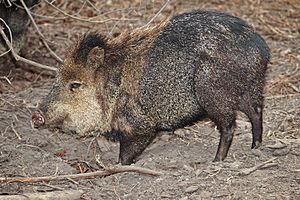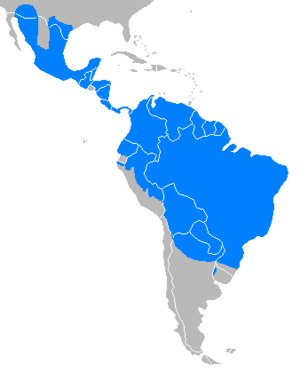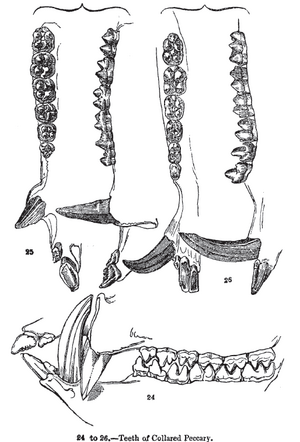Collared peccary facts for kids
Quick facts for kids Collared peccary |
|
|---|---|
 |
|
| Conservation status | |
| Scientific classification | |
| Genus: |
Dicotyles
|
| Species: |
tajacu
|
 |
|
| Synonyms | |
|
Pecari tajacu |
|
The collared peccary (Dicotyles tajacu) is a mammal that looks a bit like a small pig. You can find them in North, Central, and South America. It's the only animal in its group, called Dicotyles. People also call them javelina, saíno, báquiro, or musk hog. In Trinidad, they are known as quenk.
Even though they look like pigs, peccaries are not in the same family as true pigs. Scientists have studied them and now place them in the Dicotyles group.
Contents
What Does a Collared Peccary Look Like?
A collared peccary stands about 20 to 24 inches (51–61 cm) tall at its shoulder. It is about 3.3 to 4.9 feet (1.0–1.5 m) long. These animals usually weigh between 35 and 60 pounds (16–27 kg).
They have small tusks that point downwards. Their legs are thin, but their bodies are strong and sturdy. The peccary's tail is often hidden by its rough fur.
Where Do Collared Peccaries Live?
Collared peccaries live in many warm places across the Americas. Their home range stretches from the Southwestern United States all the way to northern Argentina. In 2017, they were brought back to Uruguay after being gone for 100 years.
The only Caribbean island where they naturally live is Trinidad. They used to live on nearby Tobago, but they are now very rare there. This is mostly because people hunted too many of them.
Different Habitats
These animals can live in many different environments. They are found in deserts, dry shrublands, and grassy areas. They also live in tropical forests and even places that flood.
Peccaries can even be found near humans, as long as there is enough cover for them. You might see them in cities and on farms. They sometimes eat garden plants there. Large groups of peccaries live in the suburbs of Phoenix and Tucson, Arizona.
Scientists once thought peccaries only recently came into the US from Mexico. But a fossil jaw found in Florida shows they lived in the southern US long ago.
What Do Collared Peccaries Eat?
Collared peccaries are mostly plant-eaters. They enjoy eating cactus, mesquite beans, and various fruits. They also munch on berries, seeds, roots, and grasses. Sometimes, they eat fungi and insects.
If they get the chance, they will also eat eggs, snakes, fish, frogs, and lizards. They might even eat dead birds or small rodents. Their favorite foods are agaves and prickly pear plants. When they live near people, they might eat garden plants like tulip bulbs.
Who Hunts Collared Peccaries?
The main animals that hunt collared peccaries are cougars (Puma concolor). Other predators include Mexican wolves (Canis lupus baileyi), coyotes (Canis latrans), jaguars (Panthera onca), and bobcats (Lynx rufus).
How Do Collared Peccaries Behave?
Collared peccaries are active during the day. They live in groups that can have up to 50 animals, but usually have six to nine. They sleep in burrows, often under bushes or tree roots. Sometimes, they sleep in caves, old mines, or among fallen trees.
However, in central Arizona, they are often more active at night. This helps them avoid the heat of the day.
Protecting Themselves
Even though they usually ignore people, peccaries will defend themselves if they feel in danger. They use their sharp tusks to fight. If a peccary is scared, it might let out a strong musky smell or give a loud bark.
Some people in the Amazon, like the Shipibos, sometimes raise young peccaries as pets. Peccaries also rub their scent on rocks and trees to mark their territory. They rub their scent on each other too, which helps them recognize their group members.
The "Giant Peccary" Story
For a while, people thought there was a fourth type of peccary called the giant peccary. It was first seen in Brazil in 2000. Local people called it caitetú-mundè, meaning "the collared peccary that is bigger and goes in pairs."
Scientists formally described it in 2007. But soon, other scientists questioned if it was truly a separate species. In 2011, a review decided that the "giant peccary" was actually just a large collared peccary. The IUCN agreed with this.
Why It Was Questioned
The "giant peccary" was said to be larger and longer-legged than the regular collared peccary. It supposedly had thinner fur and a faint collar. Some thought it weighed 88–110 pounds (40–50 kg).
Early genetic studies suggested it was a different species. However, these studies had small sample sizes. Later, more genetic evidence showed that the "giant peccary" was part of the same group as other South American collared peccaries. Scientists found that collared peccaries can look very different depending on where they live.
Images for kids
See also
 In Spanish: Pecarí de collar para niños
In Spanish: Pecarí de collar para niños







